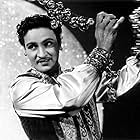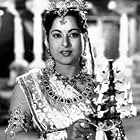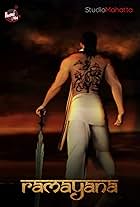Aggiungi una trama nella tua linguaThis is the story of Lord Ram and his years spent in exile with his wife and brother, and also chronicles the end of the demon king Ravan and his family.This is the story of Lord Ram and his years spent in exile with his wife and brother, and also chronicles the end of the demon king Ravan and his family.This is the story of Lord Ram and his years spent in exile with his wife and brother, and also chronicles the end of the demon king Ravan and his family.
- Regia
- Sceneggiatura
- Star
Recensioni in evidenza
Sampoorna Ramayana (1961) is an Indian movie that was directed by Babubhai Mistry. The film is based on the written Ramayana, an epic tale of Lord Rama who is an avatar of Vishnu, the Preserver. His wife, Sita, is an avatar of Lakshmi, goddess of wealth. Sita traditionally has been considered the paragon of virtues for Hindu women. She is known for her dedication, self-sacrifice, courage, and purity.
The actor who plays Ram, Mahipal, was a well known star in 1961. However, Anita Guha, who portrays Sita, was virtually unknown until she starred in this movie. The movie was extremely popular, and she became famous throughout India.
Even the DVD cover refers to the Ramayana as "mythology." I think this stems from our Judeo-Christian culture, which regards our stories as religion, and the stories of other cultures as myth. (That's why we say Greek myths or Norse myths.) The Ramayan is based on Hindu religious tradition. It is not a myth to Hindus.
What's interesting is that this religious story is full of colorful scenes, epic battles, romance, and tragedy. It's a truly fascinating account that includes a Monkey King and a demon among the characters.
In 1961 the film was probably state of the art for Indian cinema. However, the production values and acting style appear very old-fashioned almost 60 years later. What is not old-fashioned is the great music. Indian actors don't sing movie songs. These are dubbed by professional singers. Two songs in this movie are sung by Lata Mangeshkar, who is the most famous Indian film vocalist. I learned that these two songs are still popular today. (Believe it or not, we heard Lata in performance in Toronto in the 1980's. She's great.)
This isn't a film I can recommend casually to IMDb viewers. Some people will find it too old fashioned, too long, or both. Indian audiences probably will like it more than U.S. audiences. Still, it has its own niche in film history, and you might enjoy it.
We saw Ramayana on DVD, where it worked well. I suggest that you give it a try. If you don't like it, you can always hit eject.
The actor who plays Ram, Mahipal, was a well known star in 1961. However, Anita Guha, who portrays Sita, was virtually unknown until she starred in this movie. The movie was extremely popular, and she became famous throughout India.
Even the DVD cover refers to the Ramayana as "mythology." I think this stems from our Judeo-Christian culture, which regards our stories as religion, and the stories of other cultures as myth. (That's why we say Greek myths or Norse myths.) The Ramayan is based on Hindu religious tradition. It is not a myth to Hindus.
What's interesting is that this religious story is full of colorful scenes, epic battles, romance, and tragedy. It's a truly fascinating account that includes a Monkey King and a demon among the characters.
In 1961 the film was probably state of the art for Indian cinema. However, the production values and acting style appear very old-fashioned almost 60 years later. What is not old-fashioned is the great music. Indian actors don't sing movie songs. These are dubbed by professional singers. Two songs in this movie are sung by Lata Mangeshkar, who is the most famous Indian film vocalist. I learned that these two songs are still popular today. (Believe it or not, we heard Lata in performance in Toronto in the 1980's. She's great.)
This isn't a film I can recommend casually to IMDb viewers. Some people will find it too old fashioned, too long, or both. Indian audiences probably will like it more than U.S. audiences. Still, it has its own niche in film history, and you might enjoy it.
We saw Ramayana on DVD, where it worked well. I suggest that you give it a try. If you don't like it, you can always hit eject.
I just watched this film and I was absolutely enchanted. I should mention that I am not an Indian, not have I watched very many Indian films. Sampoorna Ramayana is technically simplistic and sometimes naïve (from the 2009 Hollywood point of view), but a visual delight and an inspired introduction into this chapter of Indian mythology. The musical episodes are excellent, and some are simply unforgettable (e. g. the story of god Kama – the dancing is mesmerizing - or Ram's song for Seeta or Surpankha's song or the song by the two Seeta's sons). Several episodes had an enormous element of surprise and awe for me (not to give too much away I would mention Hanuman's interrogation and Ravan's monologue among others). Speaking of actors I'd like to stress their striking looks which were quite fitting for a magical story of divine adventures. To sum it up – the film should not be judged by the modern standards but rather it should be evaluated from the point of view of its own artistic universe. Sampoorna Ramayana is ambitious and beautiful (if too long at the beginning) and a must for anyone interested in India.
Trama
Lo sapevi?
- QuizThe text following the English language "A Golden Chapter from the Glorious Heritage of India" (at the end of the credits before the movie begins) translates as : "With great faith and humbleness, we present "Sampurna Ramayan" at your service, but with this plea ! That the greatness of Lord Ram is impossible to convey in many movies let alone one ! We begin the film with the marriage of Sita..."
- ConnessioniReferenced in Consequence Karma (2021)
I più visti
Accedi per valutare e creare un elenco di titoli salvati per ottenere consigli personalizzati
- How long is Sampoorna Ramayana?Powered by Alexa
Dettagli
- Tempo di esecuzione3 ore 3 minuti
Contribuisci a questa pagina
Suggerisci una modifica o aggiungi i contenuti mancanti

Divario superiore
By what name was Sampoorna Ramayana (1961) officially released in Canada in English?
Rispondi




















